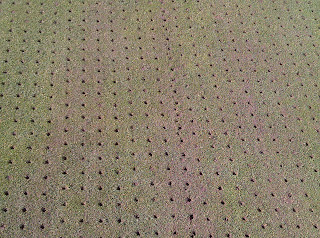As a superintendent, I will be one of the first to admit that our golf season is far too short here in Alberta. Just when you feel as though you get the property where you want it, you need to start thinking of putting it to bed for the winter. We had a tremendous season here at River Bend that gave us some beautiful days to roam the links, but alas the season has come to an end.
Following closing of the golf course, staff are very busy. All fairways, tees, surrounds, and approaches are core aerated. Core aeration is done to these surfaces to remove unwanted thatch as well as to reduce compaction. Less compated soils and reduced thatch levels better allow air to enter the root zone which improves the soil structure and root density. Tees, surrounds, and approaches are hand shovelled to remove the aeration cores. Fairways are drug with a core buster mat to break apart the aeration plugs and then the remaining thatch is vacuumed by our turf vac.
Once aeration is cleaned up, greens, tees, surrounds, approaches, and fairways are treated with chemical fungicide to help our turf combat the high disease pressure from Pink Snow Mold (Michrodochium nivale) and Grey Snow Mold (Typhula incarnata and Typhula ishikariensis). It is an unfortunate reality of our climate that nearly 50% of the year we are covered with snow, which provides an ideal growing enviroment for both diseases.
Finally, a heavy topdressing is applied to all the surfaces. The topdressing helps in two ways. On greens, it a way to protect the delicate crown (growing point) of the grass and reduce the likelihood of it from freezing in the winter. On tees, surrounds, and fairways, the heavy topdressing replaces the removed material from aeration as well as helps firm the playing surfaces. Sand naturally breaks down thatch levels which then lead to firm, more consistent playing surfaces.
In addition to all this work, staff are busy vacuuming up the seeming endless amounts of leaves that are on the ground that we did not get to while the course was open. We must also winterize the area for our Nordic season. Snow fence is installed to prevent unwanted traffic in delicate areas. Equipment is thoroughly washed and repositioned to make room for the equipment utilized in the winter. Finally, tree maintenance that was put off throughout the busy golf season is attended to. Trees that have died, or that have become unsafe on the property are removed to open areas up which also improves vistas and growing environments.
All this work is a race against the snow. The longer the winter can hold off the more of this work we can accomplish, leaving us farther ahead in the spring. The ultimate goal is to put the golf course to bed in the best possible shape as we can so that it has every opportunity to come out in the spring looking great.
In addition to all this work, staff are busy vacuuming up the seeming endless amounts of leaves that are on the ground that we did not get to while the course was open. We must also winterize the area for our Nordic season. Snow fence is installed to prevent unwanted traffic in delicate areas. Equipment is thoroughly washed and repositioned to make room for the equipment utilized in the winter. Finally, tree maintenance that was put off throughout the busy golf season is attended to. Trees that have died, or that have become unsafe on the property are removed to open areas up which also improves vistas and growing environments.
All this work is a race against the snow. The longer the winter can hold off the more of this work we can accomplish, leaving us farther ahead in the spring. The ultimate goal is to put the golf course to bed in the best possible shape as we can so that it has every opportunity to come out in the spring looking great.



























